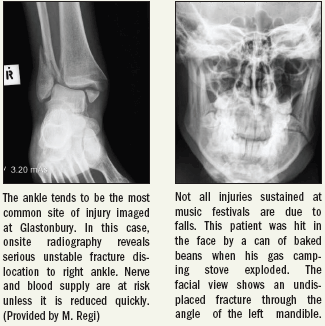Rock & roll and radiology do go together after all
Music, alcohol, perhaps a few drugs, little sleep, and an extremely slippery dance floor make for an undeniably dangerous cocktail.
Music, alcohol, perhaps a few drugs, little sleep, and an extremely slippery dance floor make for an undeniably dangerous cocktail. Little wonder that the accident rate at summer music festivals soars when it starts to rain.
The muddiness of fields at the U.K.'s Glastonbury music festival is as legendary as the bands that play there. Musculoskeletal injuries caused by falls are consequently common. Now festival goers with suspected fractures can have their limbs imaged onsite, rather than being shuttled to the nearest accident and emergency unit.

The imaging service at Glastonbury was started last year at the suggestion of Dr. Mark Regi, a registrar at the Severn Radiology School in Bristol, U.K. Most examinations were performed on a mobile digital radiography system (DRagon, Canon), loaned free of charge by Xograph Healthcare. A basic ultrasound unit was also made available, though this was used less frequently.
Radiology services were provided throughout the five-day festival by seven radiographers who each worked two eight-hour shifts. Four radiologists took turns to report plain films at early morning and evening sessions. Radiologists were also on call in case ultrasound was needed or there were problems.
A total of 93 people were x-rayed during the 2008 festival. The majority of investigations related to musculoskeletal injuries, typically involving the ankle. But several chest x-ray examinations were carried out, too. The ultrasound system was used mainly to view musculoskeletal pathology, occasionally for FAST imaging, and once for echocardiography. All images were copied onto CDs for patients to take away.
Onsite radiography confirmed 36 fractures. Stable fractures were put in plaster casts and dislocated joints relocated. Where the x-rays indicated an unstable fracture, patients were transferred offsite for further treatment.
"We found that the onsite imaging service made a positive difference in 28 patients who would previously have been transferred automatically to hospital," Regi said, during a presentation at this year's U.K. Radiological Congress. "At £200 (€230) for each ambulance trip, that's £5000 (€5900) saved."
The radiology service was expanded for the 2009 festival and the equipment budget rose from zero to £3000 (about €3500).
This year's team comprised six radiologists and as many as 12 radiographers. Ultrasound equipment was provided by Toshiba Medical Systems, while a DRagon system was this time loaned by the charity British SuperBikes (BSB).
GE HealthCare Debuts AI-Powered Cardiac CT Device at ACC Conference
April 1st 2025Featuring enhanced low-dose image quality with motion-free images, the Revolution Vibe CT system reportedly facilitates improved diagnostic clarity for patients with conditions ranging from in-stent restenosis to atrial fibrillation.
The Reading Room Podcast: Current Perspectives on the Updated Appropriate Use Criteria for Brain PET
March 18th 2025In a new podcast, Satoshi Minoshima, M.D., Ph.D., and James Williams, Ph.D., share their insights on the recently updated appropriate use criteria for amyloid PET and tau PET in patients with mild cognitive impairment.